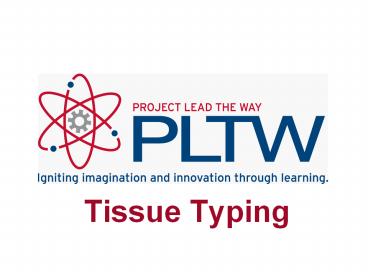Tissue Typing - PowerPoint PPT Presentation
1 / 20
Title:
Tissue Typing
Description:
When performing an HLA typing test for a kidney transplant, the following HLA antigens are ... scientists are able to determine the closeness of tissue matching. – PowerPoint PPT presentation
Number of Views:182
Avg rating:3.0/5.0
Title: Tissue Typing
1
Tissue Typing
2
Everyone has several antigens located on the
surface of his/her leukocytes
- One particular group of these antigens is called
the HLA (Human Leukocyte Antigens).
3
The HLA
- Is responsible for stimulating the immune
response to recognize tissue as self versus
non-self. - Is controlled by a set of genes located next to
each other on chromosome 6 called the Major
Histocompatibility Complex (MHC).
4
(No Transcript)
5
- The test that determines which HLA antigens are
present is called tissue typing or HLA typing. - Tissue typing identifies the similarity of the
antigens present in both the donor and the
recipient.
6
- The closer the HLA antigens on the transplanted
organ match the recipient, the more likely that
the recipients body will not reject the
transplant. - For this reason, tissue typing of the kidney
donor and recipient is necessary before a kidney
transplantation.
7
There are two main classes of HLA antigens
- Class I (HLA-A, HLA-B, and HLA-Cw)
- Class II (HLA-DR, HLA-DQ, and HLA-DP)
8
- Every person inherits each of the following
antigens from each parent - HLA-A antigen
- HLA-B antigen
- HLA-Cw antigen
- HLA-DR antigen
- HLA-DQ antigen and
- HLA-DP antigen
9
(No Transcript)
10
- The set of HLA antigens received from a parent is
called a haplotype. - There are a variety of alleles for each of these
HLA antigens.
11
- The large number of possible variations and
combinations of HLA antigens make finding a match
in a family more likely than finding a match in
the general public.
12
- When performing an HLA typing test for a kidney
transplant, the following HLA antigens are looked
at - HLA-A
- HLA-B
- HLA-DR
13
- The MHC genes are the most polymorphic known.
- There are hundreds of known alleles for each HLA
Antigen. - Each allele is identified by a number (i.e.
HLA-A1 or HLA-A2).
14
- Six HLA antigens are looked at for each person.
- Remember each person has two of each of the
antigens (one inherited from the mother and one
inherited from the father).
15
- By analyzing which six of these HLA-antigens both
the donor and recipient have, scientists are able
to determine the closeness of tissue matching. - A six-antigen match is the best compatibility
between a donor and recipient. - This match occurs 25 of the time between
siblings who have the same mother and father.
16
HLA Typing Techniques
- Traditionally, HLA typing was done using
serological techniques - Blood from the patient was mixed with serum
containing known antibodies to determine which
antigens were present. - HLA typing now is predominantly done using
molecular techniques - Patients DNA is isolated.
- PCR is used to amplify specific HLA genes.
- Genes are sequenced to determine which alleles
are present.
17
- Once the donor and recipient have been tested for
tissue compatibility, the next step is an
Antibody Screening (also called a Panel Reactive
Antibody or PRA). - A small amount of the organ recipients serum is
mixed with cells from 60 different individuals
(each test is done separately).
18
Purpose of Antibody Screening
- Scientists can determine how many different HLA
antibodies a patient has in his/her blood. - If a patient reacts with 30/60 cells, he/she is
said to have 50 Percent Reactive Antibody (also
known as PRA). - The lower a persons PRA, the less likely he/she
is to reject a transplant.
19
Crossmatch Test
- After tissue typing and antibody screening are
complete and a potential donor has been
identified, the final test is called a crossmatch
test. - Crossmatch Test A small amount of the potential
donors white cells is mixed with a small amount
of the recipients serum. - By exposing the donors HLA to the recipients
serum, scientists can determine if the recipient
has antibodies to any of the donors HLA.
20
- Positive Crossmatch A reaction between the
donors and recipients samples occurs. - Indicates that the recipients body will likely
reject the implanted kidney. - Indicates the transplant cannot be performed.
- Negative Crossmatch No reaction between the
donors and recipients samples occurs. - Indicates that the recipients body will most
likely not reject the implanted kidney. - Indicates the transplant can be performed.































